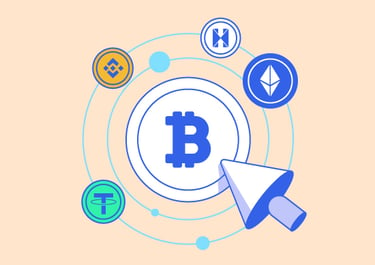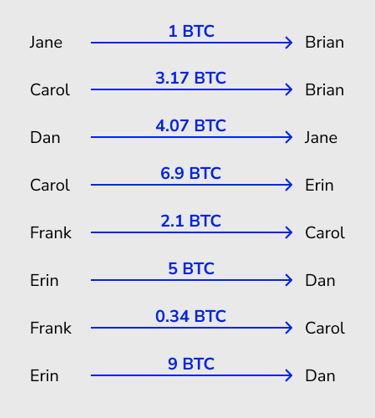What is Bitcoin?
What is Bitcoin?
Bitcoin is a digital version of money that operates differently from the fiat currencies issued by governments. Unlike traditional currencies, it is not controlled by a central bank. Instead, the Bitcoin financial system is decentralized and maintained by numerous computers located worldwide. Anyone can join this system by downloading the open-source software of Bitcoin.
Bitcoin, which was introduced in 2008 and launched in 2009, was the first cryptocurrency. It enables users to send and receive digital currency known as bitcoins (BTC). Its attractiveness stems from its inherent resistance to censorship, the prevention of duplicating funds, and the convenience of conducting transactions at any time and from anywhere.
What makes Bitcoin unique?
Here are a few of the key features that make Bitcoin unique:
1. Decentralization
Bitcoin utilizes a decentralized public blockchain, which implies that it is not governed by a central authority. Instead, the verification of transactions is carried out by a network of computers, referred to as nodes. Furthermore, anyone has the opportunity to join the network and contribute to its security.
2. Permissionless
Bitcoin's open and unrestricted characteristics enable individuals with internet access to engage in the Bitcoin network without requiring approval or consent from a central entity.
Bitcoin enables users to send and receive payments with any participant on the network, irrespective of their location or personal information. This aspect has contributed to the widespread adoption of bitcoins, especially in areas where access to conventional financial systems is limited or unavailable.
3. Limited supply
Bitcoin's protocol is designed with a predetermined limit of 21 million coins, ensuring that the total number of bitcoins in circulation will never exceed this cap. This built-in restriction serves as a safeguard against inflation.
4. Transparency
Every single transaction made with bitcoin is documented on a public ledger that is accessible to all participants. This implies that anyone has the ability to view the details of transactions, including the amount of bitcoin transacted and the addresses of the sender and recipient.
In contrast, traditional financial systems rely on banks and other financial institutions to record transactions, and this information is typically not accessible to the general public. Instead, individuals depend on these institutions to maintain accurate records.
5. Divisibility
Bitcoin can be subdivided into smaller units known as satoshis, which are equivalent to one hundred millionth of a bitcoin. This division enables individuals to utilize and conduct transactions with extremely small quantities of the currency, even if the price of a whole bitcoin rises significantly. This feature enhances accessibility to bitcoins for individuals with limited financial means and allows for more precise and detailed transactions.
How does Bitcoin work?
When Jane engages in a transaction with Brian in the Bitcoin network, the process is not akin to physically handing over a dollar bill. Instead, it resembles Jane writing on a publicly viewable piece of paper, declaring that she is transferring a dollar to Brian. Subsequently, when Brian intends to send the same funds to Carol, Carol can verify that Brian possesses the funds by examining the same piece of paper.
This piece of paper represents a database known as the blockchain, which is consistently maintained across all network participants' devices. Participants connect with each other to synchronize new information and updates.
To ensure the security and integrity of the blockchain, Bitcoin utilizes a consensus mechanism called Proof of Work (PoW). When a user initiates a payment, they broadcast the transaction to the network, where it is verified by other nodes referred to as "miners". These miners compete to solve a complex mathematical puzzle, investing computational power in the process. The first miner to solve the puzzle is granted the opportunity to add a new block of transactions to the blockchain.
As an incentive, there is a reward available for the miner who successfully proposes a valid block. This reward, known as the block reward, consists of transaction fees from the transactions within the block and the block subsidy. The block subsidy is the only source of newly created bitcoins. Each mined block adds a specific amount of coins to the overall bitcoin supply.
Bitcoin's Proof of Work (PoW) consensus mechanism is designed to make it resource-intensive to create a block, yet comparatively effortless to validate its authenticity. In the event that someone attempts to manipulate the system with an invalid block, the network swiftly rejects it, causing the miner to incur losses without being able to recoup the expenses incurred during the mining process.
What is Bitcoin used for?
Bitcoin serves primarily as a digital currency and a means of storing value. Similar to traditional currencies, it can be utilized for online or in-person purchases. It allows individuals with an internet connection to send and receive funds, with the advantage of being globally transferable due to its digital nature.
Bitcoin is occasionally employed for transactions requiring enhanced privacy. While the transactions themselves are publicly recorded on the blockchain, the addresses (public keys) associated with them are pseudonymous, though not entirely anonymous. This means that although the transactions can be viewed on the blockchain, the identities of the users involved are not easily discernible.
Furthermore, some individuals acquire bitcoins as a long-term investment, anticipating their value to appreciate over time. Comparable to gold or other commodities, the limited supply and decentralized nature of bitcoins have positioned them as a viable option for investors seeking portfolio diversification.
History of Bitcoin
Bitcoin made its debut in 2008 when Satoshi Nakamoto published a white paper titled "Bitcoin: A Peer-to-Peer Electronic Cash System." This groundbreaking document introduced a novel digital currency that would operate on a decentralized network, free from dependence on governments or traditional banking systems.
In January 2009, the Bitcoin protocol was released, leading to the first-ever bitcoin transaction between Satoshi Nakamoto and programmer Hal Finney. The transaction involved the transfer of ten bitcoins from Nakamoto to Finney.
As word spread, more individuals became aware of Bitcoin and joined the network. The digital currency gained traction among a community of technology enthusiasts who recognized its potential to operate without the need for intermediaries or central authorities.
A significant milestone in Bitcoin's history was the event known as "Bitcoin Pizza." On May 22, 2010, programmer Laszlo Hanyecz famously used 10,000 bitcoins to purchase two pizzas, making it the first recorded real-world transaction involving bitcoins as a medium of exchange. This transaction, now commemorated as "Bitcoin Pizza Day," showcased the practical application of the digital currency.
Who created Bitcoin?
The true identity of Satoshi Nakamoto remains an enigma. It is uncertain whether Satoshi is an individual or a collective of developers situated anywhere across the globe. While the name has Japanese origins, Satoshi's proficient use of the English language has led many to speculate that he or she may hail from an English-speaking nation.
Did Satoshi invent blockchain technology?
Bitcoin incorporates various established technologies, including the utilization of blockchain technology. The concept of immutable data structures, similar to modern blockchains, can be traced back to the early 1990s when Stuart Haber and W. Scott Stornetta introduced a system for timestamping documents. This system relied on cryptographic methods to ensure the security of data and protect it from unauthorized alterations, akin to the principles employed in contemporary blockchains.
How many Bitcoins are there?
The Bitcoin protocol establishes a cap of 21 million coins as the maximum supply of bitcoins. As of 2023, slightly more than 90% of this predetermined limit has been mined. However, it will require over a century to produce the remaining bitcoins. This elongated time frame is a result of recurring events called "halvings," which progressively decrease the mining reward offered for validating transactions.
What Is Bitcoin halving?
Bitcoin's halving is a process that decreases the frequency of new Bitcoin blocks being generated. It specifically refers to the scheduled events where the block rewards granted to miners are reduced. The upcoming Bitcoin halving is anticipated to occur in 2024, approximately four years after the previous halving took place in May 2020.
The concept of halving is fundamental to Bitcoin's economic model as it guarantees a gradual issuance of coins, which becomes increasingly challenging at a predictable rate. This controlled and predictable rate of monetary inflation distinguishes cryptocurrencies like Bitcoin from traditional fiat currencies, which have an essentially infinite supply.
Is Bitcoin Safe?
One of the primary concerns related to Bitcoin is the risk of hacking and theft. For instance, hackers employ social engineering techniques in phishing scams to deceive users into divulging their login credentials or private keys. Once the hacker gains access to the user's account or crypto wallet, they can transfer the victim's bitcoins to their own wallet.
Another avenue for hackers to steal bitcoins is through malware or ransomware attacks. By infecting a user's computer or mobile device with malware, hackers can gain unauthorized access to the user's Bitcoin wallet. In certain instances, hackers may also employ ransomware to encrypt a user's files and demand payment in bitcoins for their decryption.
As bitcoin transactions are irreversible and lack government-backed insurance, users must take precautions to safeguard their bitcoin holdings. This involves implementing strong passwords, utilizing two-factor authentication, and storing bitcoins in a secure crypto wallet that is inaccessible to hackers. It is also crucial to download Bitcoin-related software exclusively from reputable sources.
Another risk associated with bitcoin is its price volatility. The value of bitcoin can exhibit substantial fluctuations within short periods, posing a risk for individuals unprepared for potential losses when investing in it.
In Summary
Bitcoin, a decentralized digital currency, has garnered considerable interest in recent times. Its inception aimed to offer an alternative to conventional financial systems, functioning through a peer-to-peer network that enables direct transactions without intermediaries.
Although Bitcoin remains a relatively young technology, it is already reshaping our perception of money. As bitcoin and other cryptocurrencies progress further, it will be intriguing to observe whether they become an integral part of our daily routines.
Bitcoin in a nutshell
Bitcoin is a type of digital money known as a cryptocurrency, and it functions through a decentralized system called blockchain.
The transactions made using Bitcoin are documented on a publicly accessible ledger and confirmed by a network of nodes spread across the globe.
Bitcoin is characterized by its transparency and lack of restrictions, which has led to its growing popularity as an alternative to conventional financial systems.


DISCLAIMER & WARNING
The information provided here is presented "as is'' and is intended for general informational and educational purposes only. It does not come with any representation or warranty of any kind. This content should not be interpreted as financial, legal, or other professional advice, and it is not intended to endorse or recommend the purchase of any specific product or service. It is advisable to consult with appropriate professional advisors for personalized guidance. In cases where the article is contributed by a third-party author, please note that the expressed views belong to the author alone and may not necessarily reflect the opinions of Hata. For further details, we encourage you to read our complete disclaimer. Please be aware that the prices of digital assets can be highly volatile. The value of your investment may increase or decrease, and there is a risk that you may not recover the full amount invested. You are solely responsible for making your own investment decisions, and Hata cannot be held liable for any losses you may incur. This material is not to be construed as financial, legal, or other professional advice. For more information, please refer to Hata’s Terms of Use and Risk Warning.


